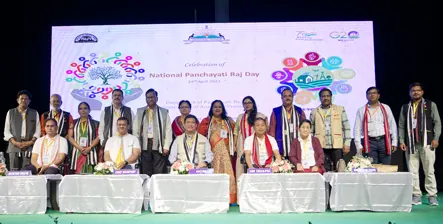ITANAGAR, 24 Apr: Chief Minister Pema Khandu advocated nine parameters to achieve the set localised sustainable development goals (LSDGs), based on the sustainable development goals (SDGs) adopted by the United Nations, for the development of villages in Arunachal Pradesh.
Speaking at the inaugural ceremony of a three-day training programme for trainers, commemorating the National Panchayati Raj Day, at the DK Convention Centre here, Khandu said that “the nine parameters as prescribed by the state’s department of panchayati raj provide a perfect roadmap for the panchayati raj institutes to plan and implement developmental projects for their respective segments.”
The nine parameters are: clean and green village, water-sufficient village, child-friendly village, healthy village, poverty-free village, ‘self-sufficient infrastructure village’, socially secured and ‘social just village’, village with good governance, and ‘gender equality village’.
“In accordance with the 17 SDGs adopted by the United Nations, of which 15 are relevant for Arunachal Pradesh, the state government has been preparing the state’s annual budgets to achieve these goals. Likewise, the PRIs now can plan to achieve these nine parameters prescribed in the LSDGs for wholesome development of villages,” he said.
Informing that Rs 123 crores was accorded to the PRIs last year – of which 75 percent is basic grant and 30 percent performance grant – Khandu said that in this year’s budget (2023-’24), “the fund for panchayati raj has been increased to Rs 143 crores.”
The state cabinet under Khandu had in September 2021 decided to devolve powers to the PRIs in the state, which had been pending for 53 years prior.
The CM informed that the devolution of powers was based on the SPICE (sustainable, participatory, inclusive, comprehensive and empowerment) formula devised by the panchayat department.
He further informed that “10 percent of the state’s own resources, in addition to finance commission grants, are being accorded to PRIs.”
“In fact, there’s no drought of funds with the state government. Things are not progressing well because the planning system is not perfect yet,” he said.
The CM reiterated his suggestion regarding convergence of similar schemes and programmes involving different departments into one and executing them at the grassroots level.
“Yes, in the last few years we have created many important infrastructures in our towns and cities, especially in Itanagar. But I will be wrong as a chief minister if I claim that Arunachal Pradesh has developed. Only when our villages are sustainably developed, I can say that Arunachal Pradesh has developed,” he said.
“For the development of the villages,” Khandu said, “the sole responsibility lies on the panchayati raj institutions.”
The chief minister reiterated that the state government, with support and guidance of the central government, is committed to develop every village of the state. He cited the recent visit of Home Minister Amit Shah to Kaho, the ‘first’ village on the Indian side of the LAC, in Anjaw district, where he launched the Centre’s ambitious Vibrant Villages Programme.
“All villages along the border – which is significant in number with Arunachal’s long international border – will be fully developed with all basic facilities. Similarly, we will
develop all other villages by convergence of state and central government schemes and programmes,” he said.
The three-day training programme will educate 225 trainers, including officers and PRI members, from across the state on 27 subjects, divided into eight sessions.
Experts have been invited as resource persons for the training programme.
Besides launching a booklet on LSDGs, Khandu inspected the model of an LSDG village set up at the venue, illustrating the nine parameters for wholesome development of a village in the convergence mode. He also interacted with members of SHGs and discussed ways of boosting cooperation for further development of tribal art.
Earlier, Panchayati Raj Minister Bamang Felix, who also attended the programme, exhorted the panchayat leaders to “play a proactive role in transforming rural Arunachal into a sustainable and self-sufficient one.”
Advising the panchayat leaders to make the best use of the state’s own resources (SOR) funds allocated to them, Felix informed that “the SOR fund to the PRIs has been increased from Rs 123 crores to Rs 143 crores in the 2022-’23 financial year,” and urged the panchayat leaders to “take up revenue-generating projects in their respective villages.”
Chief Secretary Dharmendra and PR Secretary Amarnath Talwade also spoke.
On display were various products made by SHGs at an exhibition sponsored by the union tribal affairs ministry. (CM’s & HM’s PR Cells)


